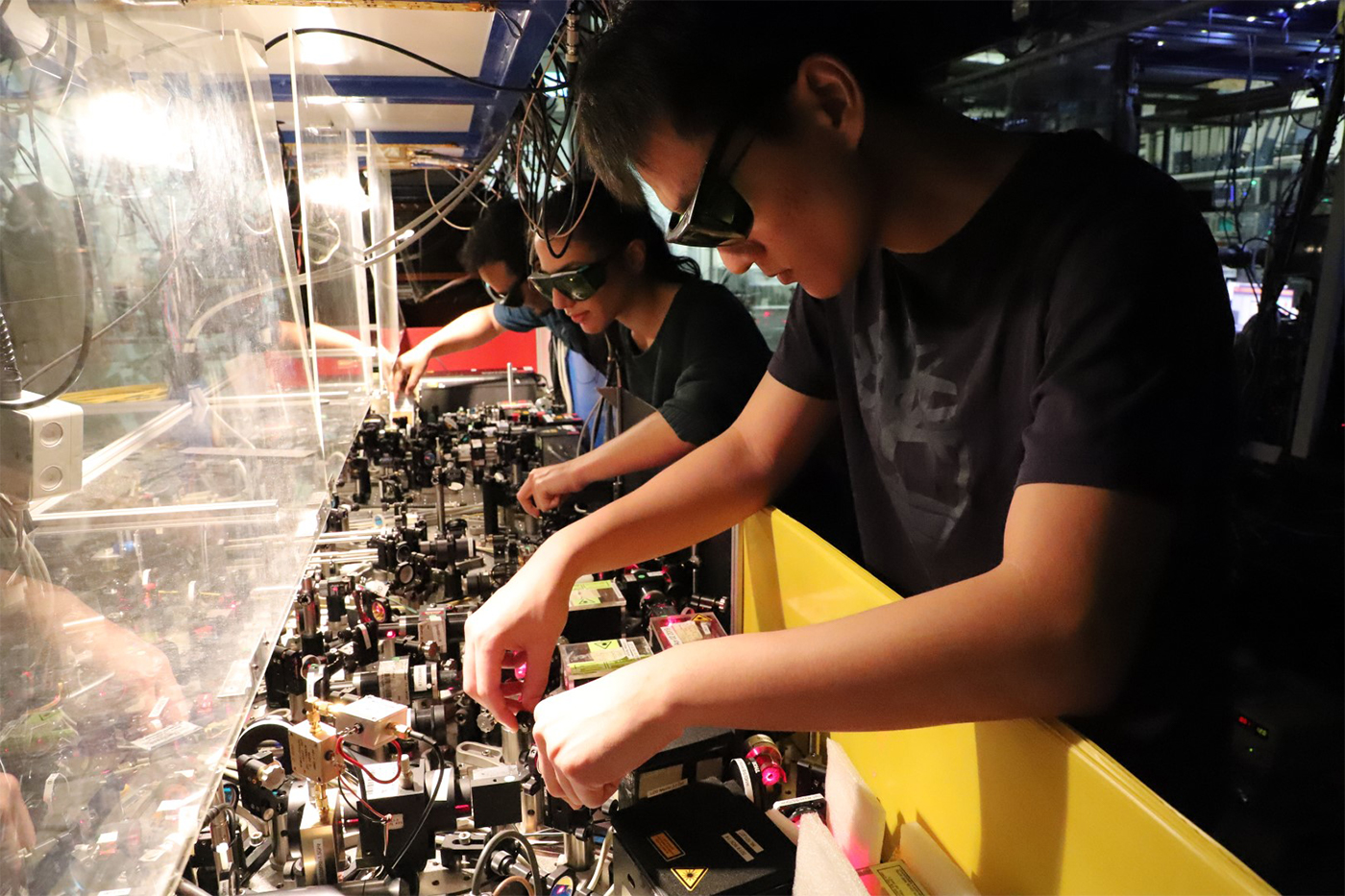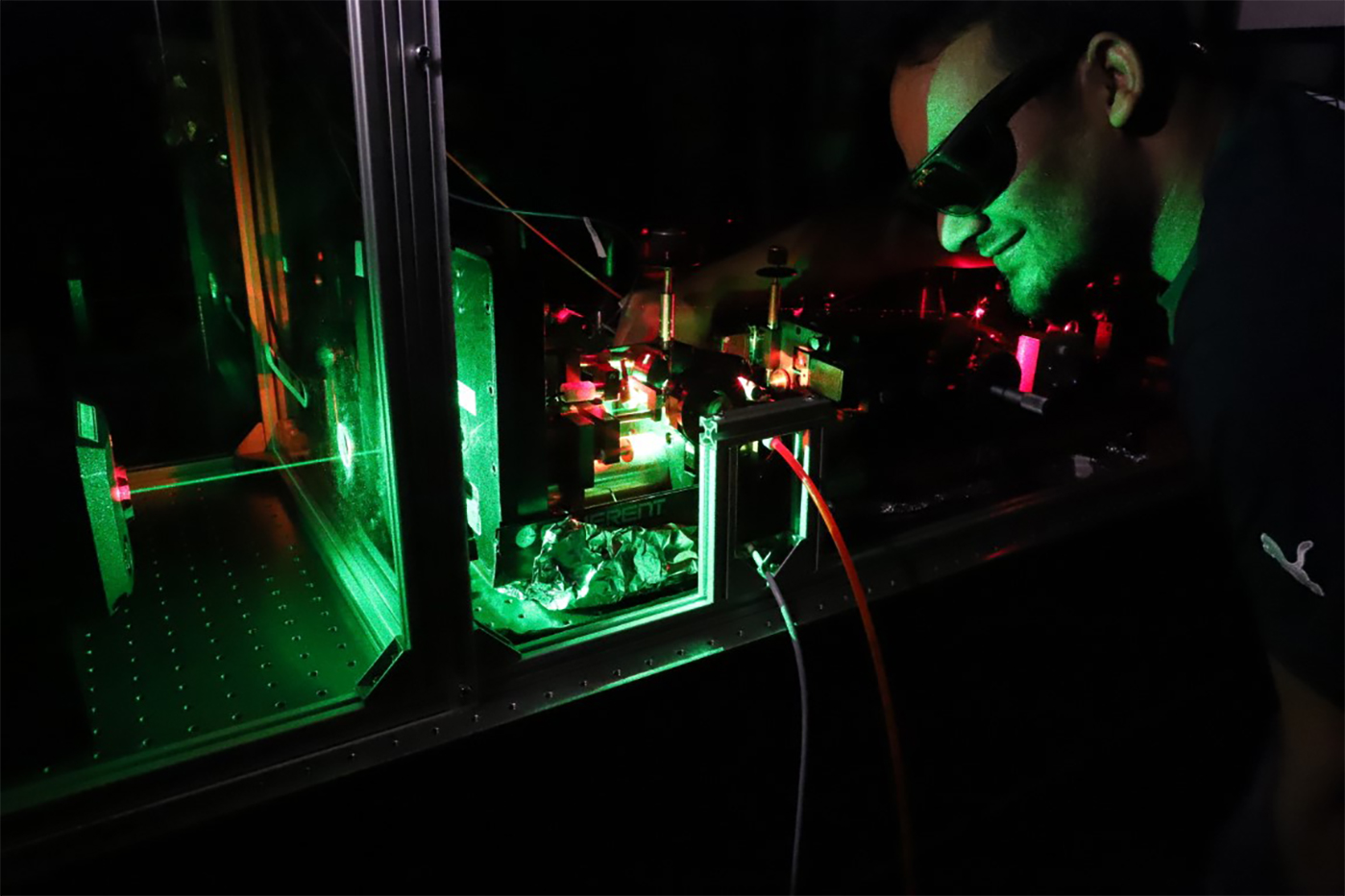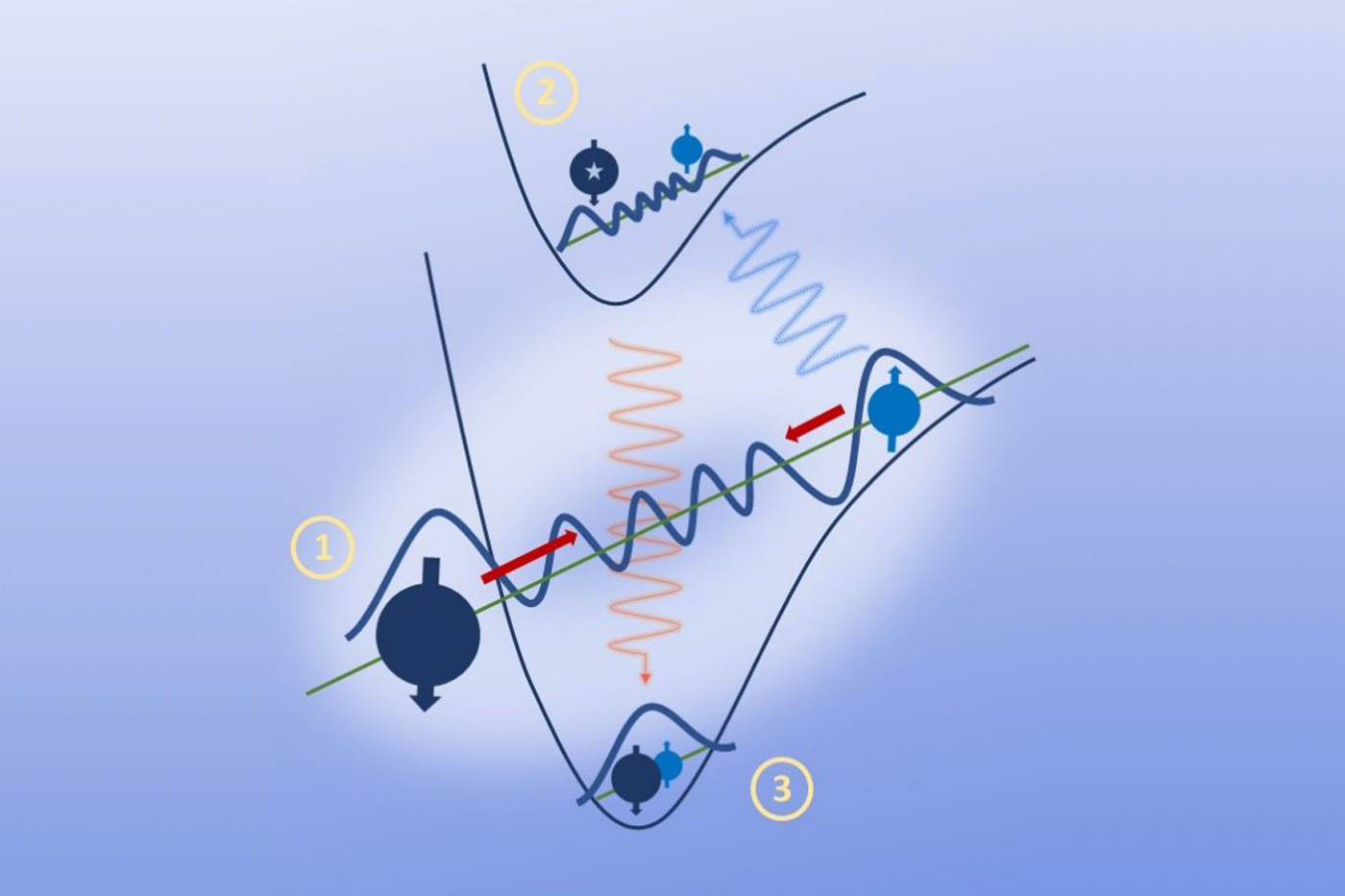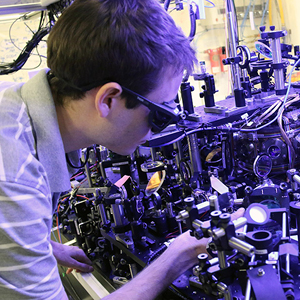Highlights
Simplified steps to make ultracold molecules lay path to study fundamental physics
 Experimental runs in this CQT lab create up to 10,000 lithium-potassium molecules at a time. Pictured at work on the experiment, from front to back, are PhD students Yang Anbang and Sofia Bosti and postdoc Sunil Kumar.
Experimental runs in this CQT lab create up to 10,000 lithium-potassium molecules at a time. Pictured at work on the experiment, from front to back, are PhD students Yang Anbang and Sofia Bosti and postdoc Sunil Kumar.
CQT researchers have found a simple and effective way to coax pairs of disparate atoms towards their coldest molecular state. The creation of such ultracold polar molecules is groundwork for experiments in quantum simulation and fundamental physics.
The work by Principal Investigator Kai Dieckmann and his team is described in a paper published in April in Physical Review Letters, “Singlet Pathway to the Ground State of Ultracold Polar Molecules”. The paper is co-authored by Kai along with current and former group members Yang Anbang, Sofia Bosti, Sunil Kumar, Sambit Pal, Mark Lam, Ieva ÄŒepaitÄ— and Andrew Laugharn.
“What we're doing is control of the quantum world in a bottom up approach,” says Kai. “With molecules, we have degrees of freedom that are vibrational and rotational. Our work has shown a wonderful way of controlling these modes,” he says.
In the lab, the team traps clouds of lithium (6Li) and potassium atoms (40K), cooling them with help from rubidium atoms (87Rb). Molecules form when Li and K pair up, with each experimental run making up to 10,000 such molecules.
Because of the atoms’ different sizes these molecules have a large electric dipole moment. That creates interesting possibilities to control and use the molecules because they interact strongly over large distances.
For example, molecules could host information in quantum computing applications. As quantum bits, they would be controlled by lasers shone onto each molecule. Their long-range interactions mean that molecules could be widely spaced for easier addressing, while still interacting in the ways required to implement logic gates. Compared to other groups around the world working with dipolar molecules, Kai’s choice of atoms offers among the largest possible dipole moments and the largest that has been produced so far.
Researchers want these molecules in their lowest-energy state to begin experiments. To get there, you usually need to know all the molecule’s energy levels, then use lasers to drive steps between these levels. Finding the energy levels involves both intensive calculations and experimental searching.
In the case of Li-K molecules, it proved difficult to find a ladder of energy levels similar to those used for other dipolar molecules. That led them to proposing a new and promising route.
The route to the ground state
The typical path to the ground state involves both singlet states and triplet states of the molecules, which differ in the orientation of the atoms’ quantum spins. Kai and his team realised they could instead make all their steps between singlet states. “With the new pathway, we use molecular states that are easier to understand and model, known as stretched singlet states. That simplifies the spectroscopy and bypasses heavy molecular structure calculations. It gives us an ideal three-level system. It’s a really clean and robust method,” he explains.
The method could be applied to other molecules too, says Kai, who has presented the findings to other groups in the field. In the current paper, the team did detailed analysis to verify the method would work and be feasible for other molecular species.
 Control of ultracold molecules requires carefully chosen and stable frequencies of light from lasers. This photo shows a dye laser in action: a green pump laser beam hits the dye jet to produce lots of red light.
Control of ultracold molecules requires carefully chosen and stable frequencies of light from lasers. This photo shows a dye laser in action: a green pump laser beam hits the dye jet to produce lots of red light.
One laboratory tool that helped the researchers with details of the new method was a vintage laser - the team purchased a refurbished dye laser that was originally manufactured in the 1980s. The group added a few modern components to obtain stable operation at high output power.
Dye lasers are no longer common because they are bulky and fiddly to operate compared to modern diode lasers, but they have the advantage of offering high power light over a vast tunable range of frequencies. That helped the researchers search for the frequencies that would most effectively drive their molecules’ transitions.
“Doing spectroscopy can be very time-consuming. It is a bit like fishing in the dark. Although we calculated the energies of the ground states with existing literature, the uncertainties were much larger than the linewidths, making the states hard to find,” explains Anbang. He suggested an approach to search through the molecules’ vibrational modes (denoted by quantum number v) to find the ground state. “I proposed to start from ground state v=3, searching from v=2, 1, 0 step by step, instead of directly searching for v=0 ground state. By doing this, we learned that our calculated energies have an offset around 3GHz from the experimental values. It accelerates our ‘searching for v=0’ process.”
The team has now identified all the energy levels that make a ladder to move the molecules to the ground state. Doing that is the next challenge. The researchers will use a technique known as Stimulated Raman Adiabatic Passage (STIRAP) with two lasers stabilised to the same cavity. They can now retire the dye laser and continue work with stable diode lasers.
 The pair of atoms start in a loosely bound molecular state (1). The molecule is first excited (2) and will then be driven into the more tightly bound ground state (3). The atoms’ spins stay arranged in a singlet-configuration as they move between these three energy levels.
The pair of atoms start in a loosely bound molecular state (1). The molecule is first excited (2) and will then be driven into the more tightly bound ground state (3). The atoms’ spins stay arranged in a singlet-configuration as they move between these three energy levels.
“The route to the ground state provides us with a robust platform,” says Sofia Botsi, who is also a PhD student on the project.
Once they have molecules in the ground state, the researchers will begin experiments in fundamental physics. A first goal is to perform quantum simulations based on the dipolar interaction to search for unusual properties of quantum materials. In particular, they are interested in a prediction that the eigenstate thermalisation hypothesis will breakdown in a disordered dipolar lattice system.
Dipolar molecules offer many avenues for further work. In the longer term, the researchers may look at using molecules for chemistry at ultracold temperatures, testing gravity at short scales or for applications such as clocks and quantum computing.
Learn more
Related Stories
Experiments reveal new potential for cold atoms in quantum simulation September 06 2018 | |
 | Creative trapping method simplifies cold atoms experiment June 08 2016 |






